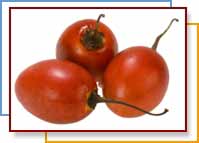Home | FOOD ARTICLES | Food Trivia | Today_in_Food_History | Food_History_Timeline | Recipes | Cooking_Tips | Food_Videos | Food_Quotes | Who’s_Who | Culinary_Schools_&_Tours | Food_Trivia_Quizzes | Food_Poems | Free_Magazines | Food_Festivals_and_Events
Food Articles, News & Features Section
FREE Magazines
and other Publications
Free Professional and Technical Research, White Papers, Case Studies, Magazines, and eBooks
TAMARILLO, Tree Tomato
The tamarillo is egg-shaped and is pointed at both ends with a green stem. The skin is tough and bitter and may be red, purple, amber, or golden yellow in color. The outer layer of apricot-colored flesh is slightly firm and the inside is filled with dark edible seeds that are slightly harder than those of a tomato. The flesh is tangy and tart, but flavorful. Tamarillos are native to South America, but most tamarillos sold in the United States are imported from New Zealand. This fruit is popular in South and Central America, the Caribbean, parts of Asia, and Australia. It is also commonly called a tree tomato.
 Selection
Selection
Select fruit that is firm, unblemished and is heavy for its size. When ripe, tamarillos should be fragrant and should yield slightly to gentle pressure. Tamarillos are available from May to October in specialty stores and some supermarkets. They can occasionally be found out of season.
Storage
Tamarillos may be ripened at room temperature, then stored in the refrigerator or eaten once they are ripe. They last up to ten days in the refrigerator if wrapped in a plastic. Tamarillos may also be frozen if they are peeled and wrapped individually.
Preparation
Tamarillos should be peeled before eating or cooking. Blanching in boiling water for 2 to 3 minutes is often the easiest way to remove the skin if the fruit is not ripe. They are often eaten raw, when ripe. Dip in frozen orange juice concentrate to sweeten the fruit and add to fruit or vegetable salads. Tamarilos are also often made into jams, chutneys and relishes.
RELATED ARTICLES
Please feel free to link to any pages of FoodReference.com from your website.
For permission to use any of this content please E-mail: james@foodreference.com
All contents are copyright © 1990 - 2025 James T. Ehler and www.FoodReference.com unless otherwise noted. All rights reserved.
You may copy and use portions of this website for non-commercial, personal use only.
Any other use of these materials without prior written authorization is not very nice and violates the copyright.
Please take the time to request permission.
